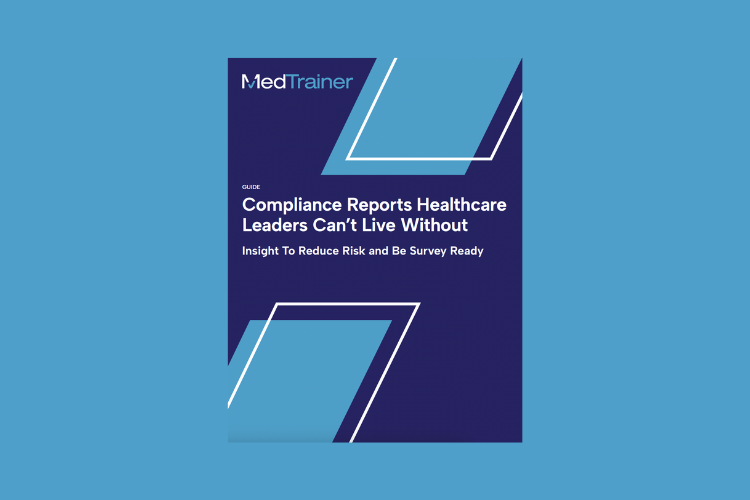Whether anticipated or spontaneous, healthcare inspections by governing agencies can be one of the most nerve-racking experiences for healthcare and compliance professionals. Surviving an OSHA inspection is serious business. The stakes are high, with an organization’s financial health, reputation, and overall legitimacy on the line.
Apart from following the rules and regulations of federal and state compliance standards, one of the greatest challenges is understanding the scope of inspections and knowing what needs to be prepared ahead of time to satisfy a surveyor. There is a lot of information to compile to ensure you can provide proof of compliance. Let’s dive into a few survival strategies for inspections by the Occupational Safety and Health Administration (OSHA).
Download “Compliance Reports You Can’t Live Without” for OSHA inspection tips.
OSHA Healthcare Inspections
What Are OSHA Inspections?
The Occupational Safety and Health Administration (OSHA) is a branch of the United States Department of Labor that monitors a variety of areas related to the safety and health of workers. Established by congress through the Occupational Safety and Health Act of 1970, OSHA ensures safe working conditions by setting and enforcing regulatory standards and by providing educational opportunities and training resources to both employers and employees.
OSHA inspections are prioritized and conducted in order from the most hazardous working environments to the least. In order of priority, opportunities for inspection include: imminent danger situations, severe injuries and illnesses, worker complaints, referrals, targeted inspections (for industries at higher risk for hazard or workplaces that have experienced high rates of injuries and illnesses), and follow-up inspections.
What Is an OSHA Inspector Looking For?
In order to know what needs to be prepared for an OSHA inspection, you need to know what the scope of the inspection might entail. OSHA has identified a set of seven core elements that businesses should implement in order to follow OSHA regulations, remain compliant, and support the overall health and safety of workers by reducing the risk of injury, illness, death, suffering, and financial hardship. The core elements that need to be addressed at your facility and considered during an inspection are:
- Management Leadership
- Worker Participation
- Hazard Identification and Assessment
- Hazard Prevention and Control
- Education and Training
- Program Evaluation and Improvement
- Communication and Coordination for Host Employers, Contractors, and Staffing Agencies
Useful Reports & Checklists for OSHA Inspections
In the event of an OSHA inspection at your healthcare facility, you can create a number of reports to show that your employees are properly credentialed, trained, and prepared to handle potential hazards as they arise. Here are some of the reports you may want to consider:
1. Licenses
Demonstrating staff competency in a particular field of practice by meeting proper licensing standards is required and helps to reduce the risk of injury, illness, death, and even hazard. A report of all licenses and certifications that require continuing education or refreshers, including medical, board-certification, first aid, restraint, de-escalation strategy, and more can be a life-saver during an inspection.
A licenses report can help to satisfy the Communication and Coordination for Host Employers, Contractors, and Staffing Agencies core element, along with Worker Participation, Education and Training, and Program Evaluation and Improvement core elements.
2. Courses
Hazard communication, bloodborne pathogens, ionizing radiation, emergency exit routes, electrical safety, emergency action plan, fire prevention, first aid, and personal protective equipment (PPE) are just a few examples of training topics OSHA could inspect at your healthcare facility.
Having a report or checklist at-hand showing the training status for each employee in these areas can save a lot of time and help to pass an inspection, satisfying the Worker Participation, Hazard Identification and Assessment, Hazard Prevention and Control, and Education and Training core elements.
3. Course Performance
The pass/fail rate of your staff training programs can be an indicator as to the quality of your course content. While some topics in your staff training program may perform well and produce a high passing rate amongst staff, other topics might have lower staff passing rates and require updates or adjustments to support employee comprehension and company compliance. By acknowledging areas for improvement in your training program, supplemented with an action plan for improvement, you are demonstrating a proactive response to enhancing your facility’s processes.
A report that displays employee course scores on the required training, with the ability to sort by department, can help to satisfy the Education and Training and Program Evaluation and Improvement core elements.
4. Incidents
Every healthcare organization is required to report incidents as they occur, whether related to equipment, patients, or employees. A summary of incidents is key to accountability and identifying areas for procedural and/or process improvement. In addition to having a robust incident-reporting system in place and easily accessible to workers, an incidents report summary can be an extremely useful tool during an inspection.
Management Leadership, Worker Participation, Hazard Identification and Assessment, Hazard Prevention and Control, Program Evaluation and Improvement, and Communication and Coordination for Host Employers, Contractors, and Staffing Agencies are all areas of OSHA’s core elements that are influenced by having an effective incident-reporting process in place, along with a report readily available to present to an inspector.
5. Safety Plans
Knowing which safety plans have been created, assigned, and acknowledged by staff can help to save lives. A collective report on safety plans also demonstrates awareness, preparedness, and readiness to an OSHA inspector.
Management Leadership, Worker Participation, Hazard Identification and Assessment, Hazard Prevention and Control, Education and Training, and Communication and Coordination for Host Employers, Contractors, and Staffing Agencies are all core elements impacted by healthcare safety plans.
6. Policies
Policies could be one of the first things inspected during a survey. An administrative report summary of which policies are in place with staff acknowledgments, is useful during an inspection. Furthermore, ensuring the policies are readily accessible to all employees is just as vital.
Having appropriate and up-to-date company policies and procedures displayed on a streamlined report can help to satisfy OSHA’s Management Leadership, Worker Participation, Hazard Identification and Assessment, Hazard Prevention and Control, Program Evaluation and Improvement, and Communication and Coordination for Host Employers, Contractors, and Staffing Agencies core elements.

The best compliance and credentialing reports to surface critical insights and keep you survey ready.
How Cloud-Based Compliance Satisfies OSHA Inspections
In addition to a healthcare facility having established company policies, an inspector will want to see that your employees can quickly and efficiently locate a policy. This will ensure everyone is on the same page and enabled to obtain any policy and its information, as needed and without delay.
By digitizing your company’s policies and procedures, your staff can avoid traversing office spaces, hunting for file cabinets, looking for binders, and sifting through papers. Your time and energy is precious in healthcare, and avoiding unnecessary stresses exacerbated by outdated systems (especially during an inspection) is invaluable.
Explore More
MedTrainer reports are customizable with the ability to create your own fields and columns for data that’s relevant to your individualized facility and staff. Furthermore, up to 6 hours a week is saved by housing all of your employee credentialing statuses and training certificates, along with incident reports, safety plans, and documents in one place. Meet with one of our experts to learn how MedTrainer can help you prepare for inspections and give you time back in the day.
